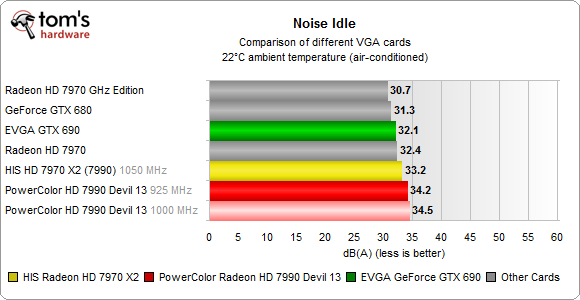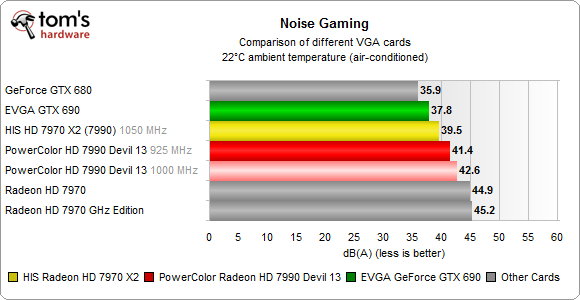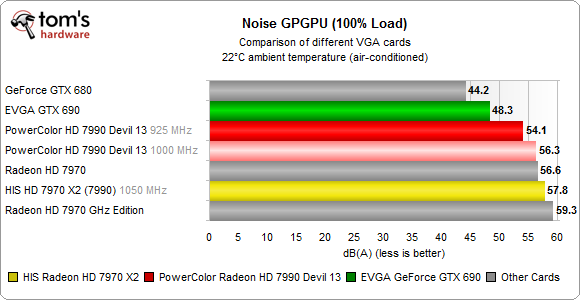Volume measurements
So far, we have taken all measurements with a regularly calibrated sound level meter from Voltcraft (SL 400 with data logger). However, since its frequency range is very limited, especially upwards, and frequencies above about 10 kHz can no longer be detected in a useful way, we had to choose a different measurement method to include the coil beeper objectively. Especially PowerColor’s Devil 13 pushed us to the limits of virtual tinitus in places, so we already want to use the test setup planned for next year for volume measurements via a specially calibrated and vibration-free suspended studio microphone.
The Devil 13 would certainly have scored better at idle, had it not been for the very high-frequency coil whine, whose spectrum is above the detection limits of normal sound level meters. So, however, only the last place remains, which is actually a pity.
When it comes to gaming, the GTX 690 can clearly set itself apart from the AMD rivals. After all, it also has the least waste heat to deal with. However, all three cards are still within acceptable limits, with the Devil 13 once again acting the loudest.
Under 100% full load, the HIS 7970 X2 then runs out of breath a bit, and it gets a bit louder than the PowerColor card. However, all rates above 50 dB(A) are actually already too loud, only the GTX 690 can clearly undercut this limit. However, this scenario is usually not the norm, so you can put this into perspective a bit in the end. The gaming results and the load-free operation in idle are the most important.
Acoustic comparison of all 3 cards
Finally, we come to the obligatory direct comparison in picture and especially sound. Again, we created a video for each scenario and then mixed the video track with the sound recorded by the sound level meter to really bring to the ear in a direct comparison what we could also already read in numbers on the previous page. The distance of the sound recording is exactly 50 cm perpendicular to the center of the card in an open setup at a constant 22°C room temperature. This time we used a very high-quality studio microphone, which we had calibrated precisely in advance.
Idle mode
Of course, everyone is interested in exactly how loud a card is when it has nothing more to do than perform normal desktop tasks. We remember: the PowerColor 7990 Devil 13 suffered from notorious coil whining even in idle. This also results in a somewhat different numerical picture, because this card would certainly have scored better without beeping.
The top score here clearly goes to EVGA and the GTX 690, which acts inaudibly in a closed case and is also barely perceptible in an open setup. This is how we imagine a quiet high-end card! HIS can also keep up without coil whining, but the Devil 13 is extremely annoying over time when working, as long as the fans do not rev up so loudly that the chirping noise is drowned out.
Coil hardcore at 500 fps
Since readers keep telling us about the reel whine at very high frame rates (in-game menus, simple or older games) and we also heard this very annoying accompanying concert very often, we test all 3 test candidates at about 500 fps in Unigine Sanctuary’s loop.
Well, each of the cards offers perceptible spooling noise in such extreme situations, even the GeForce GTX 690. However, the Nvidia card acts so discreetly that you can hardly notice the noise. HIS also has the coil whine quite well under control, while Powercolor’s Devil 13 has a bunch of virtual crickets asking for a rendezvous.
Recreated reality: gaming
Now we come to the most interesting category, because we are of course primarily interested in how the cards behave in terms of noise under normal gaming conditions. Although the cards from PowerColor and HIS in particular already have to cope with very high power losses, all three cards still perform on an acceptable level, which surprised us a bit.
The GTX 690 is still the quietest of the three cards. However, this advantage comes at the expense of the temperatures, but without having to advance into dangerous ranges. If the fan control curves of the Radeon cards were adjusted accordingly, one would certainly achieve equivalent results with a bit of luck. However, since we only want to measure what comes from the factory, we can state: Nvidia quieter, AMD cooler.
Extreme load: GPGPU
Now it’s getting hot! All cards run at 100% utilization with one Bitminer instance per chip. This scenario pushes all cards to their limits, with the PowerColor 7990 Devil 13 having the largest cooling reserves. The HIS card has to take a small toll due to the smaller and separate heatsinks, but is still master(ing) of the situation.
The winner is once again the EVGA GeForce GTX 690, even though the temperatures are a bit too high for our taste. Since this is probably not the standard scenario for most users, we can put this test into perspective a bit.
- 1 - Introduction and overview
- 2 - The challenger: HIS 7970 X2
- 3 - The efficient: EVGA GTX 690
- 4 - The beauty: PowerColor 7990 Devil 13
- 5 - Synthetic benchmarks
- 6 - Gaming benchmarks (Catalyst 12.11)
- 7 - Micro stuttering: the current situation
- 8 - Micro stuttering: AFR render methods
- 9 - Micro stuttering: adaptive VSync (Nvidia)
- 10 - Micro stuttering: dynamic VSync (AMD)
- 11 - Power consumption and temperatures
- 12 - Fan speed and noise (with videos)
- 13 - Summary and conclusion





































13 Antworten
Kommentar
Lade neue Kommentare
Urgestein
1
Urgestein
Mitglied
Urgestein
Urgestein
Mitglied
Urgestein
Urgestein
1
Mitglied
Neuling
Urgestein
Alle Kommentare lesen unter igor´sLAB Community →